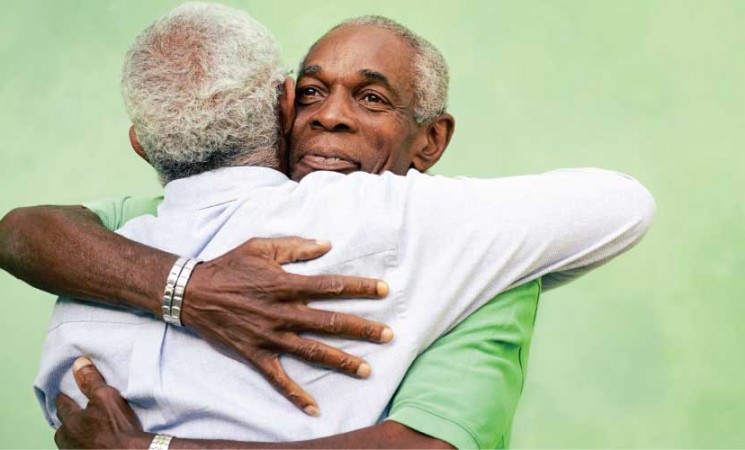Archived Content
This page is archived and provided for historical reference. The content is no longer being updated, and some of the information may have changed over time and could be outdated or inaccurate.

By Kenzie Latham, Ph.D.
Mobility limitation (i.e., difficulty walking, climbing, or standing) is one of the most common forms of functional impairment among older adults. Mobility limitation is associated with higher rates of death and nursing home admissions as well as increased health care expenditures. Typically, recovery from functional impairment is studied within confines of clinical studies and overlooked by social scientists; however, it is important to understand how social factors—such as social relationships—influence rates of recovery among older adults within their communities. Kenzie Latham, Ph.D., examines whether social connections with friends and family increases the chance of recovery from severe mobility limitation.
In a study published in The Journals of Gerontology, Series B: Social Sciences, Latham, Philippa Clarke, Ph.D., and Greg Pavela, Ph.D., used 10 years of data from the Health and Retirement Study (1998-2008) to explore whether aspects of social relationships such as availability of family support, giving and receiving help, volunteering, and visiting neighbors increased the odds of recovery from severe a mobility impairment—defined as having self-reported difficulty walking one block or across the room. Recovery was measured over a two-year interval and two outcomes were considered: partial recovery (i.e., some improvement, but still reporting difficulty walking several blocks) and full recovery (i.e., no reported difficulty walking). Because health status is known to influence social relationships, we used lagged measures of social relationships, ensuring that our social relationship measures were assessed prior to recovery.
After controlling for demographic characteristics, socioeconomic status, health behaviors, health care access and utilization, and morbidity status, providing unpaid help to friends and family increased the odds of partial and full recovery. In our sample, an older adult who lent a helping hand to family and friends had a 45% increase in the odds of completely recovering from severe mobility limitation. Additionally, having social visits with neighbors increased the odds of partial recovery. Both of these findings highlight the potential of social relationships to shape rates of recovery; staying connected with friends and family despite severe mobility limitation promoted recovery.
Because social relationships tend to vary by gender, we also investigated whether there were any differences in recovery between men and women. In general, married or partnered men were more likely to recover relative to married or partnered women. This echoes previous research noting that partnerships tend to confer health advantages to men, but not women. In addition, we found differences among men and women with regard to visiting neighbors and partial recovery. Staying engaged in the neighborhood was beneficial to both men and women, but the association was stronger in men. Disengaged women were the least likely group to experience partial recovery compared with any other group, suggesting the need for targeted intervention.
This research also reiterates the potential for social relationships to hinder recovery. Older adults who had relatives living nearby had decreased odds of complete recovery. While these data cannot tell us exactly why this association exists, previous research has documented the possible negative consequences that arise from too much instrumental support from family. In other words, when caregivers complete many of the household tasks for their aging family member with health conditions, the care-recipient may lose the ability to complete those tasks by themselves—essentially the theory of “use it or lose it.” This research, in conjunction with previous research, advocates that older adults stay active and engaged inside and outside the home.
Latham and colleagues hope that this research can speak to interventions aimed at improving mobility among older adults. Giving unpaid help was one of the most robust predictors of recovery, which emphasizes that increasing social connections among older adults with mobility limitation is mutually beneficial to social networks and communities. Older adults with severe mobility limitation or other types of impairments may be an untapped resource. It might be helpful to increase opportunities for older adults with impairment to provide help to those in need, thereby enriching the health and well-being of their communities.
Latham gratefully acknowledges the support provided by an NIA training grant from the University of Michigan (T32 AG000221) and use of the services and facilities of the Population Studies Center while at the University of Michigan, funded by NICHD Center Grant (R24 HD041028).
About the Author
 Kenzie Lantham, Ph.D.
Kenzie Lantham, Ph.D.
Kenzie Latham, Ph.D., joined the Department of Sociology at Indiana University-Purdue University Indianapolis (IUPUI) in 2013 as an Assistant Professor. Previously, Latham was an NIA Postdoctoral Fellow in the Population Studies Center at the University of Michigan’s Institute for Social Research. Dr. Latham received her doctorate from the University of Florida in 2011; her research interests include health and aging with an emphasis on functional health as well as chronic illness. Much of Latham’s research focuses on identifying and understanding health disparities among older adults.
Photo Credit: Shutterstock/ Diego Cervo








